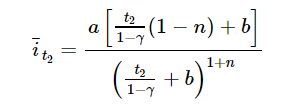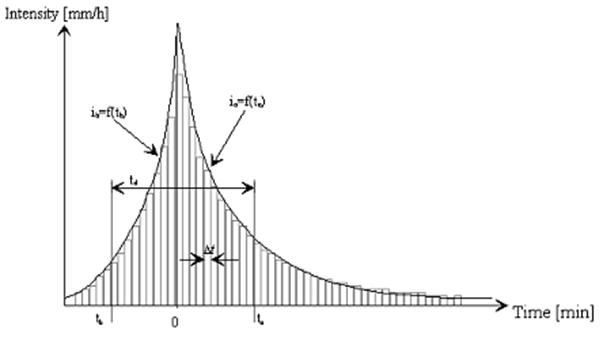Calculating Hyetograph from Chicago Storm Data
The "Chicago Design Storm" or "Chicago Method" was proposed by Keifer and Chu (1957) to calculate design rainfalls of urban storm water infrastructures. The method establishes two analytical equations for rainfall intensity over time, one valid before the peak rate and another valid after peak, both deduced from an IDF (intensity-duration-frequency) analytical expression, preserving the same volumes of all rainfall intensities.
The method is further extended to a case that user can input a pre-built Intensity-Duration curve table and instead of using the above mentioned two equations for the intensity hyetograph an "Alternating Blocks Method" is used to obtain the intensity hyetograph from the IDF table.
These two use cases are described as follows:
- To use an IDF equation:
In this case the Sherman I-D equation is used for a return period:
In which i is the intensity, t is the duration, a,b,n are coefficients.
With all these data ready, the method uses following two equations to generate an intensity hyetograph:
Before peak:
After peak:
In which r is the Peaking-Time-Ratio, the graph below shows the t1 (tb) and t2 (ta) orientations (0 is where the peak is located):
- To use a user-defined
Intensity-Duration curve table:
In this case a method of "Alternating Blocks" is used. The steps for this method are as followings:
- Using I‐D‐F curve to find rainfall intensities i for Δt, 2Δt, 3Δt, etc.
- Using i to compute P for Dt, 2Dt, 3Dt, …. This gives cumulative P
- Compute incremental precipitation from cumulative P
- Pick the highest incremental precipitation (maximum block) and place it in the middle of the hyetograph. Pick the second highest block and place it to the right of the maximum block, pick the third highest block and place it to the left of the maximum block, pick the fourth highest block and place it to the right of the maximum block (after second block), and so on until the last block




